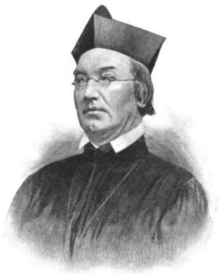John Early | |
|---|---|
 | |
| 26th & 28th President of Georgetown University | |
| In office 1870–1873 | |
| Preceded by | Bernard A. Maguire |
| Succeeded by | Patrick Francis Healy |
| In office 1858–1865 | |
| Preceded by | Bernard A. Maguire |
| Succeeded by | Bernard A. Maguire |
| 1st & 5th President of Loyola College in Maryland | |
| In office 1866–1870 | |
| Preceded by | Anthony F. Ciampi |
| Succeeded by | Edward Henchy |
| In office 1852–1858 | |
| Succeeded by | William Francis Clarke |
| 3rd President of the College of the Holy Cross | |
| In office 1848–1851 | |
| Preceded by | James A. Ryder |
| Succeeded by | Anthony F. Ciampi |
| Personal details | |
| Born | July 1, 1814 Maguiresbridge, County Fermanagh, Ireland |
| Died | May 23, 1873 (aged 58) Washington, D.C., United States |
| Resting place | Jesuit Community Cemetery |
| Alma mater | |
| Orders | |
| Ordination | July 1, 1845 |
John Early SJ (July 1, 1814 – May 23, 1873) was an Irish-American Catholic priest and Jesuit educator who was the president of the College of the Holy Cross and Georgetown University, as well as the founder and first president of Loyola College in Maryland. Born in Ireland, he emigrated to the United States at the age of nineteen. Upon his arrival, he enrolled at Mount St. Mary's Seminary in Maryland and entered the Society of Jesus, completing his education at Georgetown University in Washington, D.C.
Early became president of the College of the Holy Cross in 1848, where he unsuccessfully petitioned the Massachusetts legislature to charter the school. Four years later, he was charged with establishing Loyola College in Maryland, which was intended to educate the lay students who attended St. Mary's Seminary and College, which the Sulpicians sought to keep as a seminary only. While also serving as the first pastor of St. Ignatius Church, he oversaw the early years of Loyola College. He also established its high school division, which later became Loyola Blakefield. In 1858, Early left to become president of Georgetown University. During the Civil War, instruction continued uninterrupted, despite intermittent occupation by the Union Army and dwindling enrollment.
Early then returned to Loyola College in 1866 as president for four years, where he resumed the annual conferral of degrees. In 1870, he once again became president of Georgetown University. He died suddenly in his third year of office.